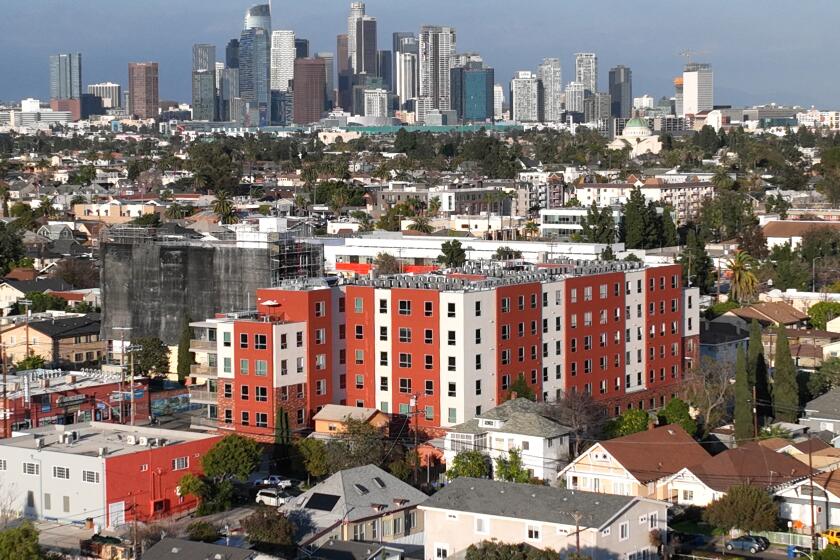Natural History Museum warehouse stores heads and tales
- Share via
The Los Angeles County Natural History Museum has quite a skeleton crew in the city of Vernon. Thousands of bones are stored in the museum’s Large Mammal Warehouse there, including those of a wayward whale, a temperamental polar bear, a freedom-seeking hippo and a historic fire horse.
The eerily-quiet specimens, some with gaping jaws filled with giant teeth, are kept in the sign-less building for research or future display in the Exposition Park museum.
But some are just too unwieldy to be moved -- for example, “giant whale ribs that don’t fit through the . . . museum’s freight elevator,” noted the Naturalist, the museum’s magazine. One celebrity occupant, Minnie the whale, is in a different category -- her skeleton is in too many pieces for display.
The 63-foot-long behemoth’s body was spotted bobbing in the surf off Long Beach on May 4, 1897, by a lad identified in the newspapers only as “barefoot Charlie.” The spectacle attracted workers for a house-moving company who roped and towed her ashore.
Minnie was left in the sand there for several days, becoming, in effect, Long Beach’s first tourist attraction. Railroads offered special “Whale Excursions” for sightseers. “It’s interesting how the whole town seemed to show up in their Sunday finest for a family portrait next to a dead whale,” commented museum zoologist Jim Dines. Before being donated to the museum, Minnie had several other owners who cut her skeleton into pieces so that it would fit inside buildings. But it’s still of interest to some of the scientists who visit the warehouse from as far as New Zealand, Australia and Japan.
“Because her skull was cut up,” Dines explained, “scientists have the opportunity to see where her brain case was. They can compare the shape of the skull cavity with that of whales that lived millions of years ago. It helps trace the evolutionary history of the species.”
The warehouse also houses the skeleton of a polar bear who made headlines when he attacked his trainer in 1917 in a Los Angeles arena near the corner of Washington Boulevard and Main Street. “The trainer’s screams brought people rushing from all directions,” The Times reported.
Policeman C. E. Abel, who was walking his beat nearby, raced over and fired several rounds, killing the animal. The trainer, Jack Bonavita, died from his injuries. As a side note, The Times reported that 12 years earlier, the unfortunate Bonavita had had his right hand “eaten from the arm by a lion at Coney Island.”
Speaking of famous bones, the museum warehouse also became the last stop for Bubbles, the hippo who escaped from the old Lion Country Safari Park in Irvine in 1978 and evaded capture for 19 days. When she finally emerged from a pond, park rangers felled her with tranquilizer darts and she was given a shot of a calming drug. Rangers were shocked to discover soon afterward that the creature had died. The reason was that when she collapsed, her internal organs pressed against her lungs and she suffocated. An autopsy revealed that she was pregnant.
The animal’s skeleton is in pieces these days and does not attract many scientists. But, recently, Dines took Bubbles’ skull to the Dinosaurs Ball, a museum fundraiser, and related her story. More than 30 years have passed since her death but, Dines said, “most of the guests were familiar with her.”
The skeleton of Blackie is a reminder of another poignant story. Blackie was the last L.A. city fire horse, whose job was to “race and sweat down hardened highways, pulling a fire apparatus with clanging bells,” as the Fireman’s Gazette put it.
Horses were phased out of the department by 1921, and Blackie spent the next 18 years of his life in comfort in Griffith Park, dining “on green grass, with hay and oats as dessert,” the Gazette said. Then, in 1939, a fire broke out not far from his retirement home.
Blackie, 37, “sniffed the air excitedly” and gazed “at a distant plume of black smoke,” a Times article said.
“He knew that the firemen were at grips with his ancient enemy.”
Perhaps, the newspaper continued, Blackie could not bear to miss “the fight he knew so well.”
The animal collapsed and died before the fire was doused. Blackie’s skeleton was later put on display in the museum as part of a mammal exhibit, but it’s back in the warehouse, idle for the moment.
You could say Blackie’s still on call.
--
More to Read
Sign up for Essential California
The most important California stories and recommendations in your inbox every morning.
You may occasionally receive promotional content from the Los Angeles Times.










